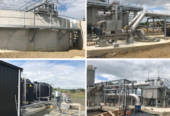Last week I discussed our tectonic plates and the Hikurangi Subduction Zone (HSZ).

Janine Krippner
It’s important to understand these processes and not just as a geologist. If you’re a Marvel movie fan, to quote Peter Quill – it’s important “because I’m one of the idiots who lives in it!” I’m not calling anyone an idiot, I just like the quote.
We are fortunate to have incredible mountains, habitats, and resources thanks to our geological processes. We also aren’t powerless when it comes to the scarier aspects. We can take action to ensure we are less impacted and can recover faster when our faults move. The first step is to understand them, which has been ongoing for decades thanks to seismologists and other experts.
We know that tectonic plates move at about the same speed that your fingernails grow, causing significant change over millions of years. When the faults between or within them move quickly we get earthquakes. Subduction zones like ours produce the world’s largest earthquakes and tsunamis, like the horrific 2004 Boxing Day (Sunda subduction zone) and 2011 Tōhoku (Japan Trench) events.

Tsunami. Photo: Mikhail Nilov pexels.com
When we see an earthquake location on a map it is represented as a dot, but earthquakes are movement of rock across a plane. Imagine holding two books and sliding them past each other. The epicentre is the spot on land above where the earthquake begins, and where it begins below the surface is the hypocentre. Earthquakes are so complex that seismologists simplify the information so we can all understand the important bits quickly.
To simplify it, the greater the area that quickly slips, the longer the shaking and the bigger the magnitude. The Richter scale is no longer used as it’s not accurate, if you see this term in the media it’s not correct. It can take longer for a larger area to slip. When this makes the ground move upwards below the ocean, this can trigger the large tsunamis. That’s why we say if it’s long or strong get gone (evacuate from a beach and go uphill).
The potential size of an earthquake is related to the area of a fault that could move. The Tōhoku earthquake was so impactful because movement occurred over an area 400km long and 150km wide. Recent research shows that there’s a one in four (25%) chance of a major earthquake in our HSZ during the next 50 years. It is also capable of producing a magnitude nine earthquake, like the Tōhoku event.
We have over 500 mapped faults in Aotearoa that could produce a magnitude six-plus earthquake. You can explore the known active onshore faults in the “New Zealand Active Faults Database” online. Thankfully we are not powerless.
Earthquakes can happen at any time so it’s important that we remember what to do. Always drop, cover, and hold until the earthquake is over. If you try to move you can be knocked over or become a target for dangerous falling objects. Have a household plan, where would you meet if you are separated? There is plenty of important advice at getready.govt.nz.
We can’t predict when a major earthquake will occur, or the size, but we can take action to improve our chances of being okay. We have the power to get through these events together, just as many people around the world do each year.








